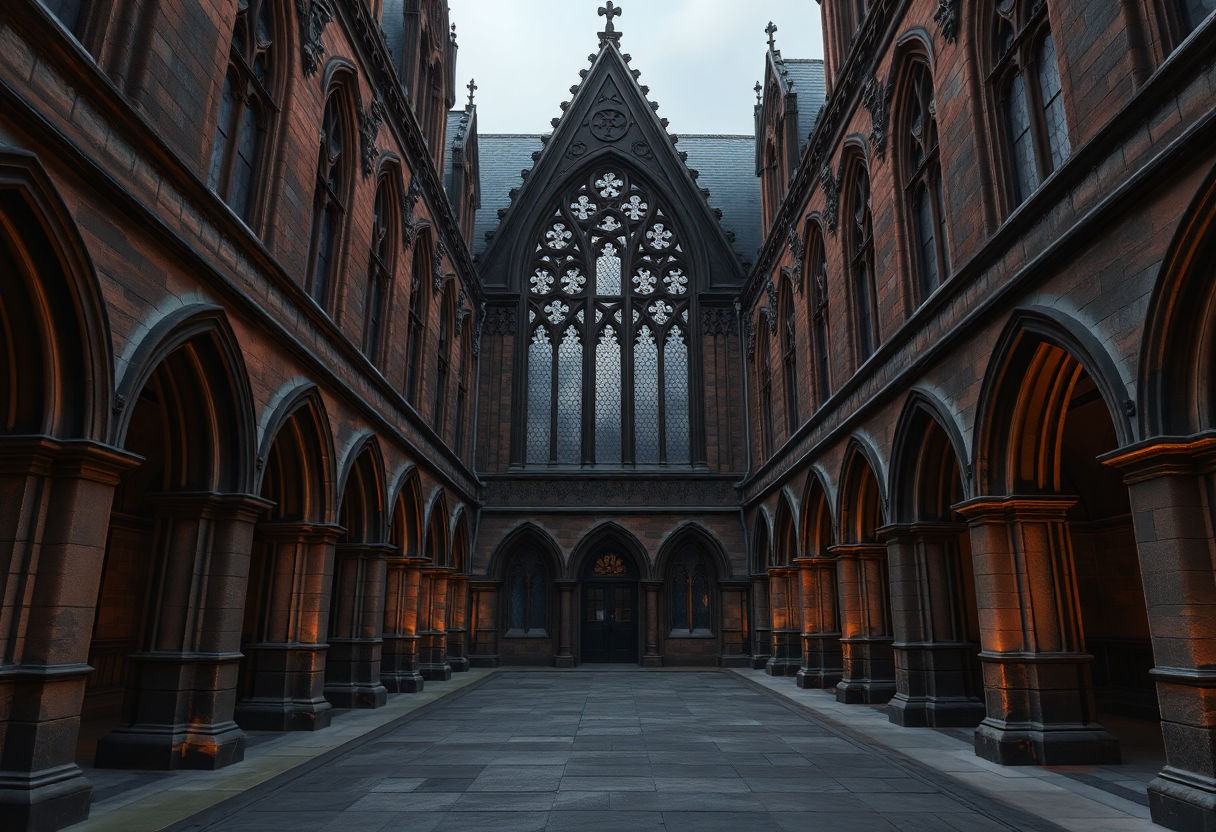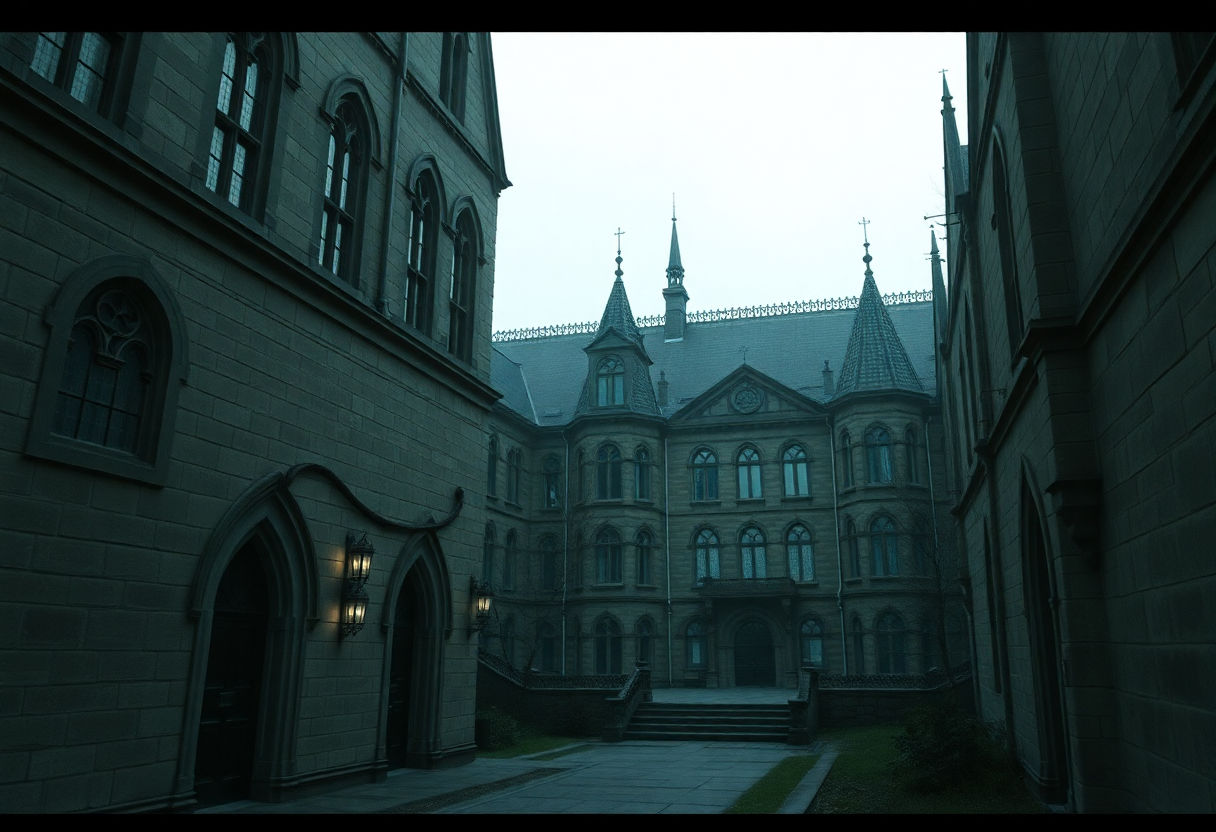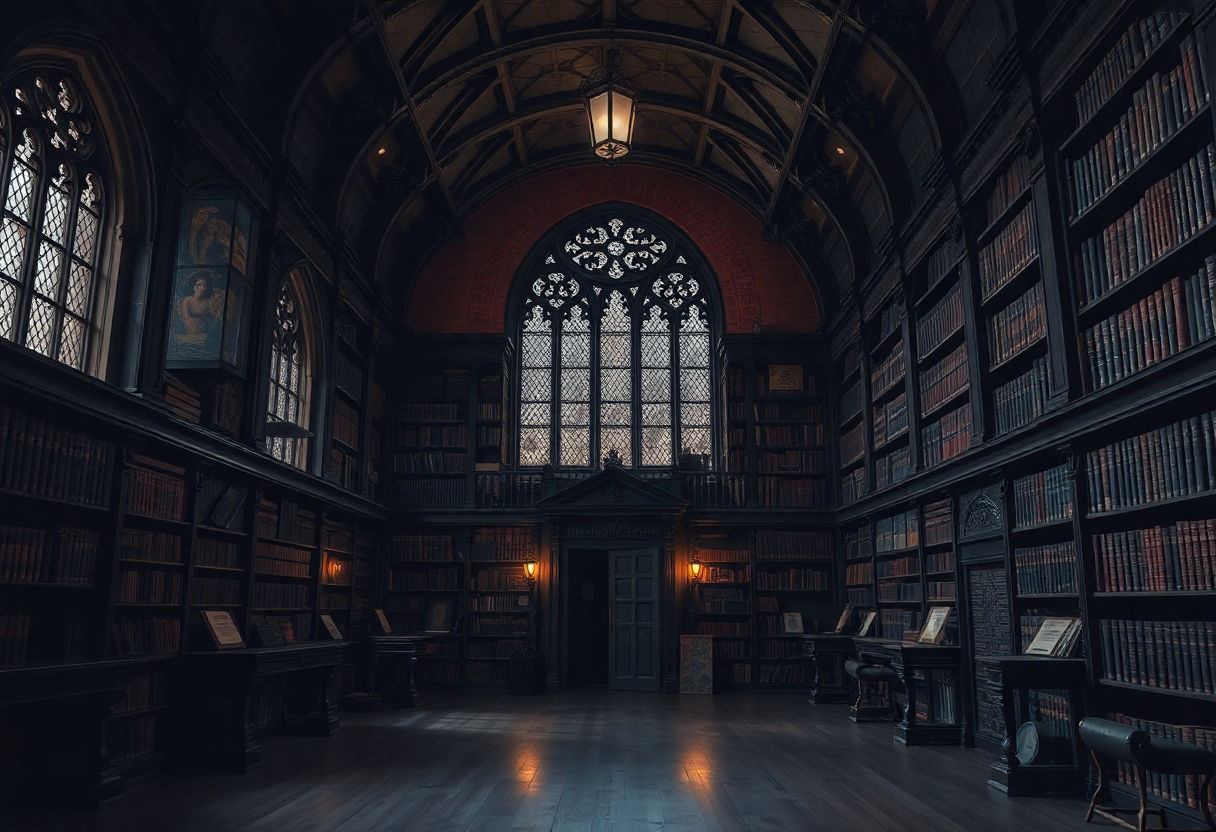Step into the captivating realm of Gothic Dark Academia, a harmonious confluence of somber aesthetics and profound philosophical inquiry. This fascinating cultural current draws its inspiration from an array of sources, including literature, architecture, and fashion. At its core lies a rich tapestry woven with historical depth and existential exploration. As you delve deeper, unravel the intricacies of Gothic influences and academic ideals that shape its unique allure. From its aesthetic dimensions to modern adaptations, this article seeks to illuminate the enduring appeal of Gothic Dark Academia, inviting readers to explore its complex layers of mystery and intellect.
Key Takeaways
- Gothic Dark Academia is a captivating fusion of Gothic and academic aesthetics, deeply rooted in historical literature, architecture, and modern fashion.
- The aesthetic draws heavily from Gothic literature, using its narrative elements to explore existential themes and philosophical questions.
- Key Gothic elements such as architectural details and somber color palettes enhance the mysterious and scholarly ambiance.
- Fashion in Gothic Dark Academia reflects a unique style that blends traditional academic attire with dark and moody elements, emphasizing individuality and intellectualism.
- The modern revival of Gothic Dark Academia in contemporary media showcases its enduring cultural appeal and the continuous interplay between knowledge and mystery.
Historical Origins

Gothic Dark Academia’s roots can be traced back to the 18th and 19th centuries, a period when Gothic literature began to captivate audiences with its mysterious and often eerie tales. This literary movement introduced a complex interplay of romanticism, supernatural elements, and profound emotional depths, which profoundly influenced the narrative framework of Dark Academia. Novels like Mary Shelley’s Frankenstein and Edgar Allan Poe’s The Fall of the House of Usher painted a world characterized by decay, isolation, and the sublime—a world that continues to resonate within Dark Academia.
The architectural heritage of the Gothic era, with its towering spires, intricate stone masonry, and dramatic arches, laid the groundwork for the visual aspects of Gothic Dark Academia. Universities and colleges across Europe and the United States, many of which were built during the Gothic revival movement of the 19th century, serve as quintessential backdrops for this aesthetic. These educational institutions, with their vaulted ceilings and shadowy cloisters, mirror the enigmatic charm celebrated in Gothic Dark Academia.
Simultaneously, modern fashion has drawn inspiration from both these literary and architectural influences. The aesthetic often incorporates Victorian-era elegance with a focus on dark color palettes, lace, and layered fabrics. The fashion epitomizes a blend of historical influences and contemporary interpretations, capturing the aura of scholarly pursuit and gothic mystery. This cultural resurgence keeps the allure of Gothic Dark Academia alive, allowing it to continually evolve while maintaining a deep connection to its historical origins.
Philosophical Underpinnings

Gothic Dark Academia is steeped in a rich tapestry of philosophical inquiries that delve into the realms of existentialism, nihilism, and the human condition. This aesthetic invites one to ponder profound philosophical questions, prompting exploration beyond the surface.
At its core, Gothic Dark Academia embraces existential themes, raising questions about the purpose and meaning of life. The characters within Gothic narratives often grapple with their identities and place in an indifferent universe. This mirrors existential philosophy, where individuals must construct their own meanings in a world that offers none intrinsically. The allure of mystery and the unknown found in Gothic literature resonates deeply with such existential musings, encouraging a contemplative and reflective mindset.
Moreover, the aesthetic often evokes nihilistic sentiments, confronting the void and futility of human endeavors. It embraces the darkness—both literally and metaphorically—juxtaposing elegant decay against the pursuit of knowledge and truth. The aesthetic confronts one with the notion that in the grand scheme of existence, humanity’s artistic and intellectual pursuits may be ultimately inconsequential. Yet, there lies a beauty in these pursuits, echoing Friedrich Nietzsche’s idea of crafting personal significance amidst apparent chaos.
The interplay of light and shadow, success and despair, found within Gothic Dark Academia not only shapes its visual and narrative components but also enriches its philosophical complexity. This aesthetic challenges the viewer to reconcile the romanticism of knowledge with the stark realities of existence, thus fostering a unique space for introspective thought and intellectual exploration.
Gothic Elements in Dark Academia

In the realm of Dark Academia, Gothic elements play a pivotal role, lending the aesthetic its haunting charm and intellectual allure. The integration of Gothic architecture threads through the aesthetic, drawing from its characteristic features of spires, pointed arches, and ribbed vaults. This architectural style, reminiscent of the awe-inspiring cathedrals and ancient universities of Europe, imbues Dark Academia with a sense of history and mystery.
The aesthetic often gravitates towards settings that include vast libraries with towering shelves and dimly lit studies. These spaces echo the solemn grandeur of Gothic design, emphasizing introspection and scholarly pursuits. Elements like stained glass windows and elaborate stone carvings enhance the ambiance, creating an environment that is both intellectually stimulating and deeply introspective.
Additionally, Dark Academia borrows heavily from Gothic literature, which frequently explores themes of forbidden knowledge, the supernatural, and the macabre. Works by authors such as Mary Shelley and Edgar Allan Poe influence the narrative texture of this aesthetic, inviting an examination of human nature and existential dilemmas. These literary influences inspire a fascination with life’s more shadowy aspects, fueling the philosophical quest for understanding within the aesthetic.
In essence, the infusion of Gothic elements into Dark Academia aesthetic anchors its visual and thematic identity, crafting a world where intellectual curiosity meets the enigmatic allure of the past. This fusion results in an aesthetic that captivates through a profound, almost melancholic beauty, drawing individuals into its richly storied tapestry.
Fashion and Style
The sartorial dimension of Gothic Dark Academia constitutes a striking blend of elegance and mystery, where clothing serves as a visual narrative of its core philosophies. This aesthetic draws inspiration from the intellectual and somber heritage of the scholarly world, marked by thoughtfully selected garments that resonate with Gothic splendor and academic gravity.
A quintessential feature of this fashion style is its rich and muted color palette, incorporating deep blacks, forest greens, rich burgundies, and charcoal grays. These colors are not merely stylistic choices; they embody the moody and contemplative essence that is central to Gothic Dark Academia, representing introspection and a profound connection to history’s artistic and literary pursuits.
In terms of clothing, the choices are both deliberate and layered, evoking an aura of intellectual nostalgia. Tailored blazers, wool tweed coats, and vintage cardigans often feature prominently, reflecting an affinity for classic scholarly attire. Long flowing skirts, lace details, and high-collared shirts contribute to a look that is both romantic and steeped in historical allusions. Accessories such as leather-bound books, vintage eyeglasses, and timeworn satchels further encapsulate the aesthetic, serving as both practical items and symbolic artifacts.
The style’s affiliation with Gothic elements is evident in the incorporation of lace, velvet, and brocade fabrics, which add texture and opulence, enhancing the aura of anachronistic elegance. This fusion of academia and Gothic whimsy creates a distinct and immersive aesthetic experience, blurring the lines between the worlds of reality and imagination. Thus, Gothic Dark Academia, through its fashion and style, offers a tangible means to engage with its intellectual and aesthetic dimensions.
Interplay of Knowledge and Mystery
In the enigmatic realm of Gothic Dark Academia, an intricate dance unfolds between the pursuit of knowledge and the allure of mystery. This aesthetic captivates its audience by merging intellectual curiosity with the shadows of the unknown, creating a narrative that is both intellectually stimulating and deeply mysterious.
At the heart of Gothic Dark Academia lies a profound admiration for the world of scholarship. Libraries, ancient texts, and hallowed academic halls serve as the backdrop for an exploration of intellectual endeavors. This reverence for learning is not merely an appreciation for facts and theories but rather an understanding of the depths of human curiosity and the endless quest for enlightenment.
Parallel to this pursuit of knowledge is the ever-present undercurrent of mystery. Gothic Dark Academia thrives on the enigmatic and the arcane, drawing inspiration from the rich tapestry of Gothic literature and architecture. Shadows play a significant role in setting the tone, hinting at the profound secrets hidden within the corridors of academia. The aesthetic invites the curious to delve deeper, questioning the unknown forces that shape our understanding.
The interplay of these elements reflects a deeper philosophical stance, one that acknowledges the limitations of human comprehension. It celebrates the notion that not all can be known and that mystery has its own intrinsic value. As such, Gothic Dark Academia becomes not just an aesthetic, but a lens through which to perceive the balance between the empirical and the esoteric, inviting individuals to embrace both the visible and the hidden in their journey of discovery.
Modern Adaptations

Contemporary media and cultural spaces have witnessed a profound revival of the Gothic Dark Academia aesthetic, with its influence pervading various dimensions of popular culture. This aesthetic has not only made its way into literature and cinema but has also permeated the realms of interior design, fashion, and digital media.
In the film and television landscape, the resurgence of Gothic Dark Academia is evident in productions that echo its classic themes. Movies and series often depict mysterious academic settings—grand libraries, ivy-clad universities, and dimly lit study rooms—capturing the essence of its allure. These narratives are imbued with a sense of nostalgia and enigma, mirroring the aesthetic’s intrinsic fascination with the past.
Moreover, the aesthetic’s appeal is vividly reflected in modern interior and architectural design. Dark wood, antique furniture, and subdued lighting create spaces that evoke an atmosphere reminiscent of the hauntingly beautiful Gothic era. This style offers a sophisticated and thoughtful ambiance, blending intellectual curiosity with a taste for the dramatic.
On social media platforms, the Gothic Dark Academia aesthetic finds a dynamic revival through curated content that highlights both the visual and philosophical aspects of this trend. Online communities, notably on platforms like Instagram and Pinterest, celebrate this style through art, mood boards, and literary quotes, cultivating a virtual sanctuary for its admirers.
In fashion, this aesthetic’s influence is undeniable, as runways and retail embrace its distinctive elements. Rich textures, layered garments, and a color palette dominated by blacks, deep reds, and muted neutrals define collections that cater to those drawn to a more profound artistry in everyday apparel. This modern reinterpretation maintains the core philosophies of Gothic Dark Academia while adapting to a fast-paced, contemporary world.
Conclusion
The allure of Gothic Dark Academia endures due to its profound blend of aesthetics and philosophical introspection. By interweaving rich Gothic traditions with intellectual pursuits, it evokes a world where mystery and academia coexist seamlessly. As this aesthetic continues to inspire modern adaptations, it challenges us to reflect on existential themes and appreciate its cultural influence. Embracing this style encourages an exploration of knowledge, wrapped in the elegance and enigma of the Gothic tradition, promising to inspire future generations to seek beauty and meaning in the shadows of academia.
Frequently Asked Questions
What defines Gothic Dark Academia as an aesthetic?
Gothic Dark Academia is defined by its fusion of Gothic elements with intellectual pursuits, often characterized by a somber and scholarly atmosphere. It emphasizes introspection, mystery, and a connection to both historical and literary influences.
How is Gothic literature integral to Dark Academia?
Gothic literature is integral because it provides the narrative depth and existential themes that are central to Dark Academia. This genre inspires the aesthetic’s focus on romanticism and melancholy, exploring the human psyche and societal constraints.
What role does fashion play in Gothic Dark Academia?
Fashion in Gothic Dark Academia serves as a visual representation of its core themes: nostalgia, darkness, and intellectuality. Key clothing elements include timeless pieces like tweed blazers, turtlenecks, and muted color palettes reflecting the aesthetic’s mood.
How do Gothic architectural elements influence the aesthetic?
Gothic architectural elements, such as pointed arches, vaulted ceilings, and intricate stonework, contribute to the aesthetic by creating an environment that mirrors its themes of historical grandeur and enigma. This architecture sets a stage for intellectual exploration and reflection.
Why is the interplay of knowledge and mystery significant in this aesthetic?
The interplay of knowledge and mystery is significant as it captivates the imagination, intertwining academic curiosity with enigmatic allure. This balance reflects the search for deeper truths and hidden meanings in both intellectual and aesthetic experiences.



